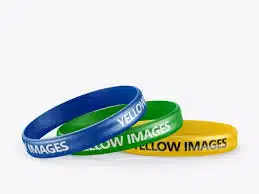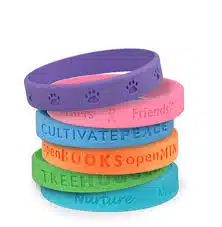Table of Contents

In daily life, rubber wristbands are often seen as simple accessories for sports or fashion, but their value extends far beyond basic decoration. With advantages like softness, durability, low cost, and high customizability, rubber wristbands have quietly become indispensable tools in professional fields such as medical care, business operations, and education. This article will explore the unique applications of rubber wristbands across various industries, revealing how this small item creates significant value through practical innovation.
The Critical Role of Rubber Wristbands in Medical Settings
In healthcare, where precision and safety are paramount, rubber wristbands have evolved into a core component of patient care systems. Their ability to combine durability with functionality makes them irreplaceable in medical environments.
Patient Identification: A Lifesaving Tool
The most fundamental yet vital application of rubber wristbands in healthcare is patient identification. Unlike paper labels that tear easily or metal bracelets that cause discomfort, medical-grade rubber wristbands are designed to withstand repeated disinfection, water exposure, and daily wear. Each wristband is printed with critical patient information—name, medical record number, blood type, allergies, and primary diagnosis—ensuring that every medical procedure, from medication administration to surgery, is performed on the correct patient.
A study by the Joint Commission on Accreditation of Healthcare Organizations found that hospitals using rubber wristbands for patient identification reduced medication errors by 68% compared to those using traditional methods. In emergency rooms, where time is critical, nurses and doctors can quickly verify patient details by glancing at the wristband, minimizing delays in treatment. For patients with limited communication abilities, such as those in a coma or with dementia, rubber wristbands serve as a reliable voice, conveying life-saving information when the patient cannot.

Specialized Care for Vulnerable Populations
Rubber wristbands play a targeted role in managing care for vulnerable patient groups. In pediatric wards, colorful rubber wristbands with cartoon patterns help reduce children’s anxiety about hospital stays while still carrying essential medical data. For patients with infectious diseases, color-coded rubber wristbands—red for airborne precautions, yellow for contact precautions—alert healthcare workers to necessary safety protocols, preventing cross-contamination.
In mental health facilities, rubber wristbands are used to track patient movement and treatment schedules. Unlike rigid identification systems, their soft texture reduces the risk of injury, and their tamper-resistant design ensures patients cannot remove them without staff knowledge. This balance of safety and comfort makes rubber wristbands a staple in psychiatric care, where patient cooperation and security are equally important.

Innovations in Medical Monitoring
Advancements in technology have expanded the role of rubber wristbands beyond static identification. Smart rubber wristbands embedded with sensors now monitor vital signs such as heart rate, blood oxygen levels, and skin temperature in real time. These devices are particularly valuable for post-operative patients or those with chronic conditions like hypertension, as they transmit data to medical staff remotely, enabling early intervention if abnormalities are detected.
For patients undergoing rehabilitation, rubber wristbands with adjustable tension markers guide proper movement. Physical therapists set personalized ranges on the wristbands, allowing patients to self-monitor their exercises at home and avoid overexertion. This not only accelerates recovery but also empowers patients to take an active role in their care—a shift that has been shown to improve long-term outcomes.
Rubber Wristbands: Transforming Business Operations
Beyond healthcare, rubber wristbands have become a versatile tool in the business world, offering cost-effective solutions for branding, event management, and customer engagement. Their adaptability and customizability make them a favorite among marketers and operations managers alike.
Branding: Wearable Marketing That Resonates
In an era of digital overload, rubber wristbands provide a tangible way for brands to connect with consumers. Companies across industries—from sports apparel to tech startups—use custom rubber wristbands as part of their marketing strategies. These wristbands feature brand logos, slogans, or unique designs that turn customers into walking brand ambassadors.
A notable example is a global energy drink company that distributed rubber wristbands at music festivals, each printed with a QR code linking to exclusive content. Attendees shared photos of the wristbands on social media, generating over 500,000 organic impressions and increasing product sales by 15% in the region. Unlike traditional ads that are easily ignored, rubber wristbands are worn daily, keeping brands top-of-mind and fostering long-term brand loyalty.
Streamlining Events with Wristband Systems
Large-scale events such as conferences, concerts, and trade shows face logistical challenges in managing crowds, verifying credentials, and ensuring security. Rubber wristbands have emerged as a solution to these issues, replacing paper tickets and lanyards with a more efficient system.
At international tech expos, for instance, tiered rubber wristbands—black for VIPs, blue for attendees, and green for staff—simplify access control. Security personnel can quickly identify authorized individuals by wristband color, reducing wait times at entry points by up to 40%. Wristbands are also tamper-proof; once fastened, they cannot be removed without tearing, eliminating ticket scalping and unauthorized entry. This level of security is invaluable for high-profile events where crowd management is critical.
Enhancing Customer Loyalty Programs
Businesses in the service sector, such as gyms, hotels, and restaurants, use rubber wristbands to strengthen customer loyalty. Members of fitness centers receive personalized rubber wristbands that grant access to facilities, track workout milestones, or unlock exclusive classes. This not only streamlines check-in processes but also creates a sense of community among members, who recognize fellow enthusiasts by their wristbands.
Hotels have adopted similar strategies, offering guests rubber wristbands that double as room keys and loyalty program identifiers. Guests with elite status receive branded wristbands entitling them to perks like late check-out or complimentary upgrades, enhancing their experience while reinforcing brand prestige. These programs have proven effective: hotels using rubber wristbands report a 20% increase in repeat bookings compared to traditional loyalty systems.
Beyond Medical and Business: Rubber Wristbands in Daily Life
The utility of rubber wristbands extends to education, public welfare, and daily convenience, demonstrating their versatility as a problem-solving tool.
Safety and Organization in Education
Schools and universities use rubber wristbands to enhance student safety and streamline administrative tasks. During field trips, teachers assign color-coded rubber wristbands to different groups, making it easy to track attendance and ensure no student is left behind. In elementary schools, wristbands printed with emergency contact information provide peace of mind, as staff can quickly reach parents in case of accidents.
Universities also leverage rubber wristbands for campus events, such as orientation or sports games. Wristbands serve as tickets, access passes, and even meal vouchers, reducing the need for multiple documents and simplifying the student experience. This efficiency has made rubber wristbands a staple in educational institutions, where managing large groups of students is a constant challenge.
Empowering Public Welfare Campaigns
Nonprofit organizations and advocacy groups have embraced rubber wristbands as a means to raise awareness and funds for social causes. The iconic yellow “Livestrong” wristband, launched to support cancer research, demonstrated the power of rubber wristbands as a symbol of solidarity. Since then, countless campaigns—from environmental conservation to mental health awareness—have used custom wristbands to unite supporters and drive action.
For example, a marine conservation group sold blue rubber wristbands inscribed with “Protect Our Oceans,” donating a portion of proceeds to clean-up efforts. The wristbands became a visible sign of commitment, encouraging wearers to share their involvement on social media and recruit others to the cause. This grassroots approach has proven highly effective: campaigns using rubber wristbands often see a 30% increase in donor engagement compared to traditional fundraising methods.
Practical Uses in Daily Life
Beyond professional settings, rubber wristbands offer simple solutions to everyday problems. They organize tangled charging cables, prevent glasses from slipping off noses, and even serve as temporary hair ties. Gardeners use them to secure plants to stakes without damaging stems, while pet owners attach them to collars as lightweight ID tags with contact information.
These creative applications highlight the adaptability of rubber wristbands. Their low cost and durability make them a go-to tool for DIY enthusiasts and anyone seeking practical, affordable solutions to daily inconveniences.
Why Rubber Wristbands Succeed: Key Advantages
The widespread adoption of rubber wristbands across industries can be attributed to several core advantages:
- Durability: Made from high-quality silicone, rubber wristbands withstand wear and tear, water, and temperature changes, ensuring long-lasting use.
- Customizability: From colors and logos to embedded technology, rubber wristbands can be tailored to specific needs, making them suitable for any application.
- Cost-Effectiveness: Compared to metal IDs, electronic devices, or paper systems, rubber wristbands are inexpensive to produce, even in large quantities.
- Comfort: Their soft, flexible design makes rubber wristbands comfortable to wear for extended periods, increasing user acceptance.
The Future of Rubber Wristbands
As technology advances, the potential of rubber wristbands continues to grow. Innovations such as biodegradable materials, enhanced sensors, and integration with mobile apps promise to expand their functionality further. We may soon see rubber wristbands that monitor environmental pollution, track carbon footprints, or even serve as digital wallets, blending seamlessly into the Internet of Things.
In healthcare, future rubber wristbands could communicate directly with medical devices, automatically adjusting treatment plans based on real-time data. In business, they may integrate with augmented reality, offering personalized shopping experiences or interactive event content. Whatever the future holds, rubber wristbands are poised to remain a versatile, indispensable tool across industries.
From saving lives in hospitals to building brand loyalty in businesses, and from enhancing safety in schools to driving social change, rubber wristbands have proven their value as more than just accessories. Their unique combination of durability, customizability, and affordability has made them a staple in professional and daily life alike. As we continue to innovate, the applications of rubber wristbands will only expand, solidifying their role as a small but powerful solution to big challenges. Whether in medical settings, business operations, or community initiatives, rubber wristbands are here to stay—quietly transforming how we live, work, and connect.